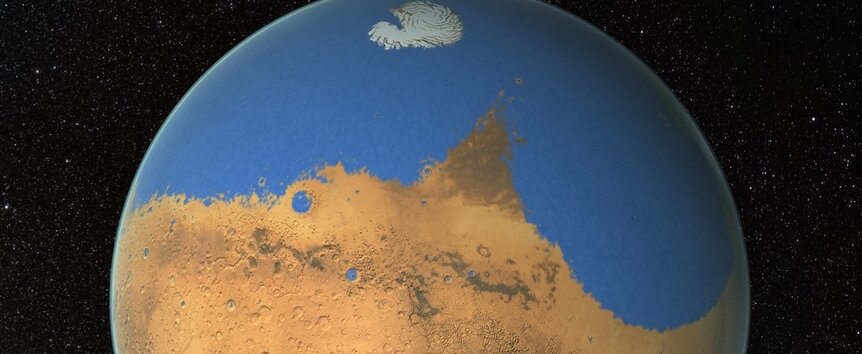Create a free profile to get unlimited access to exclusive videos, sweepstakes, and more!
Mars didn't just have oceans, it had mega tsunamis
Nice ocean you have there, would be a shame to smash it with an asteroid.

The 2019 science fiction movie The Wave (now streaming on Peacock!) follows the unbelievable exploits of Frank — no last name — as played by Justin Long. He isn’t a likeable character per se, despite Long’s particular charms, reveling in denying an insurance claim and reaping the financial rewards he’ll gain as a result. During a night of celebration, after successfully finding a way to deny the insurance claim for a firefighter who died of a heart attack, Frank is exposed to an unnamed hallucinogen and immediately blacks out.
When he wakes the next day, he’s treated to a high-flying, drug-induced adventure which changes the way he sees the world and his place in it. It’s basically a modern retelling of A Christmas Carol but with way more drugs. Frank's metaphorical wave may have felt out of this world, but it can’t compare with the truly devastating mega waves which rocked Mars 3.4 billion years ago.
It was during what is known as the Hesperian Period on Mars, a period of about 800 million years, dating from 3.7 to 2.9 billion years ago. It was a time of intense change, following the heavy bombardment of the previous Noachian period. Impacts slowed down, though they didn’t stop completely, more on that in a minute. Instead, the Hesperian was dominated by intense geological and environmental change on Mars. Volcanism was slowing down, though still dumping sulfur and water into the environment, and the planet was cooling down. Much of its liquid water, which may have once been deep enough to cover the entire planet in a 300-meter-deep ocean, was locking itself underground or in permafrost. When an impactor did hit the planet, however, the water locked underground would burst forth in incredible flash floods which washed over the Martian landscape.
In 1971, NASA sent its Mariner 9 spacecraft to the Red Planet, which discovered the first evidence of fluvial landscapes — fluvial refers to landscapes shaped in part by waterways like rivers and streams — and that discovery has dominated the exploration and study of Mars ever since, thanks to the exciting potential for the existence of ancient Martian life. A few years later, NASA sent its Viking 1 lander to Maja Valles, an outflow channel in Chryse Planitia.
RELATED: The Dead Red Planet Part 1: If ancient Mars had oceans, where exactly were they?
Frustratingly, observations from Viking 1 were difficult to explain. The landing site was expected to be a flood outwash deposit, but didn’t have the characteristic features scientists expected to find. For years the origin of the features at the Viking 1 landing site remained something of a mystery. Some have hypothesized that the site might have once been near the margins of an ancient sea, and its unusual characteristics could be the result of a mega tsunami caused by an asteroid impact.
That’s where scientists from the Planetary Science Institute, NASA Ames Research Center, The University of Arizona, and colleagues from around the world come in. They continued the work begun by Mariner 9, in a new paper published in the journal Scientific Reports.
An impact-caused mega tsunami fit the observations at Maja Valles, but scientists needed to find the smoking gun, or rather the planetary bullet hole. They scoured maps of Mars in search of a suitable impact crater and found one which might have been the site of an ancient impact followed by a devastating mega wave.
The crater, dubbed Pohl, lies about 900 kilometers away from the Viking 1 landing site, but it turns out that’s close enough, as long as your tsunami is powerful enough to reach it. The impact crater is 110 kilometers in diameter, which is more or less comparable to the crater left over after the destruction of the dinosaurs.
Researchers attempted to reverse engineer the asteroid itself from the impact crater and came up with two possibilities, both of which depend on the overall resistance of the impacted sediment. Simulations show that a 3-kilometer object impacting relatively soft ground, or a 9-kilometer object impacting denser terrain, traveling at speeds of 10.6 kilometers per second, would have been sufficient to carve out a 110-kilometer crater.
The simulations showcase a devastating natural disaster with crustal material ejected several kilometers into the alien air and waves several hundred meters in height. According to the recreations, waves are believed to have diminished in height relatively quickly while still carrying their kinetic energy to distant locales. Not only was the impact and the ensuing tsunami powerful enough to reach the Viking 1 landing site 900 kilometers away, but scientists estimate the waves would have traveled nearly twice that distance, petering out about 1,500 kilometers from the impact site.
If there was any nascent life grasping for a toe hold on that early Martian landscape, the impact and tsunami would have made for a particularly bad day. At least Mars didn’t have any dinosaurs — as far as we know! — microbes get back up a little easier than 20-ton sauropods. If we’re lucky, we’ll find out once and for all if Mars had any creepy critters in its distant past, when rock samples from the Perseverance rover return to Earth in the 2030s.



























